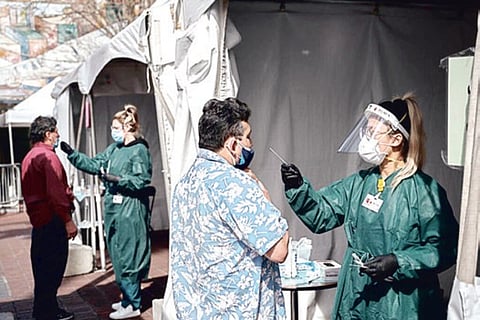

Chennai
At its peak, Dodger Stadium was testing 16,000 people a day for the virus, making it the biggest testing site in the world, said Dr. Clemens Hong, who oversees coronavirus testing in Los Angeles County. But in January, the city pivoted, converting the stadium into an enormous, drive-through vaccination site. Local demand for coronavirus testing has plummeted, Dr. Hong said. He said that he saw the evidence first-hand recently when he visited a community hospital: “The testing site had three people and the vaccine site had a line around the block.” Los Angeles is not an anomaly. Across the nation, attention has largely shifted from testing to vaccination. The United States is now conducting an average of 1.3 million coronavirus tests a day, down from a peak of 2 million a day in mid-January, according to data provided by the Johns Hopkins Coronavirus Resource Center.
In some ways, the decline is good news, and can be attributed, in part, to falling case numbers and the increasing pace of vaccination. But the drop-off also worries many public health experts, who note that the prevalence of COVID-19 remains stubbornly high. More than 50,000 new cases and 1,000 deaths are being tallied every day and just 14 percent of Americans are fully vaccinated. “We are very much worried about resurgence,” said Jennifer Nuzzo, an epidemiologist at Johns Hopkins University. “Everybody mentally moved on to vaccines. Obviously, vaccines are quite important. But as long as the majority of us are not protected, then testing remains essential.” The $1.9 trillion stimulus package signed into law this month includes $47.8 billion earmarked for testing, tracing and monitoring the virus. But as society begins to reopen and vaccines roll out more widely, testing strategies are evolving.
Here are reasons that testing still matters, and how officials see the next months, and years, playing out. Case numbers remain high, and clinicians still need to identify individuals who have contracted the virus so that these people can receive proper treatment and care. The gold standard for diagnosing COVID-19 is the polymerase chain reaction, or P.C.R., test, which can identify even small traces of genetic material from the coronavirus. This kind of testing will be needed as long as there are COVID-19 cases, but as the disease becomes less common, diagnostic testing is likely to become less centralised. “The game has changed a bit,” Dr. Hong said. “Before, we just had infection popping up everywhere, and we needed broad, blanket testing access. Now we need to be more targeted.”
Diagnostic testing is shifting from large, government-run sites to smaller, more distributed sites that are spread across local communities, Dr. Hong said. Ultimately, when vaccination rates are high enough and cases are low enough, dedicated testing sites will not be needed at all. “Then we just return testing to the health care system,” he said, and coronavirus tests will simply be one of many options on the menu at the doctor’s office.Testing is important not just for identifying individual patients who need treatment but also for public health. When the system is working, a timely COVID-19 diagnosis is what triggers contact tracing and quarantining and can stop virus transmission in its tracks.
“The vaccine — marvellous, miraculous as it is — is not in and of itself going to contain this pandemic,” said A. David Paltiel, a professor of health policy and management at Yale School of Public Health. Slowing transmission means fewer people will get sick but it also gives the virus fewer opportunities to mutate. And that reduces the odds that dangerous new variants — some of which may be able to evade vaccine-induced immunity — will emerge. Keeping community spread low will help give vaccines “a fighting chance,” Dr. Paltiel said.
Anthes is a journalist with NYT©2020
The New York Times
Visit news.dtnext.in to explore our interactive epaper!
Download the DT Next app for more exciting features!
Click here for iOS
Click here for Android